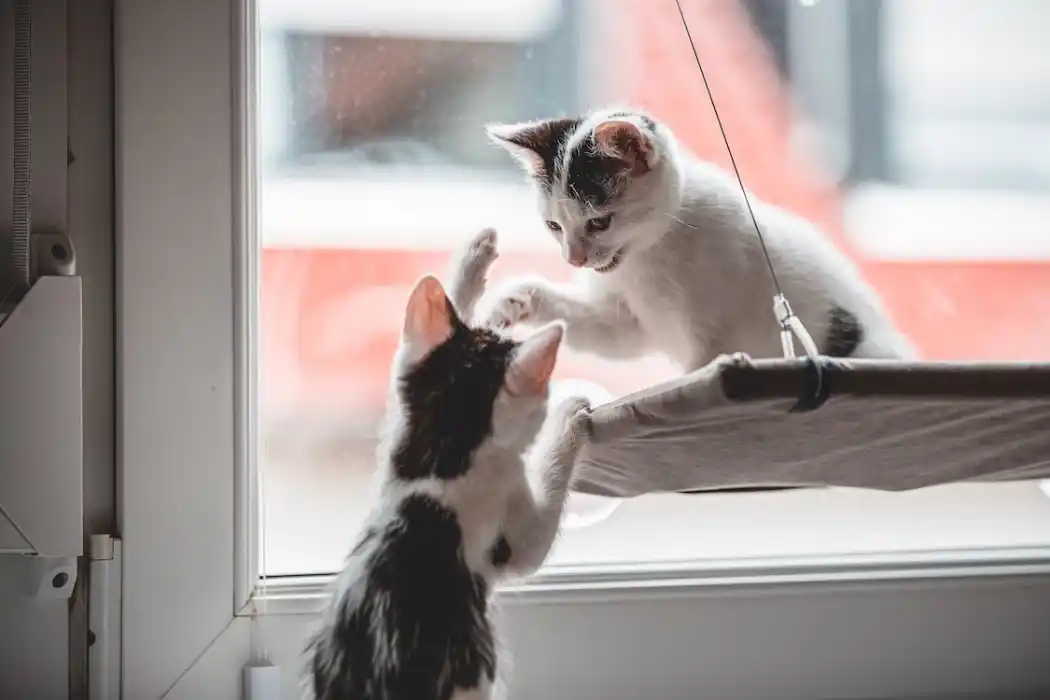How to prevent your cat from rejecting a new kitten

Published by: Tatsiana Korshik
Time to Read: 6 Min

How to prevent your cat from rejecting a new kitten
Introducing a new kitten to a resident cat can be a delicate process. To help prevent your cat from rejecting the new kitten, follow these steps:Gradual introduction: Start by keeping the new kitten in a separate room, allowing your resident cat to become familiar with their scent and presence. Use a baby gate or door crack to allow visual and olfactory interactions between the two cats without direct physical contact.
Scent swapping: Exchange bedding or blankets between the cats to further familiarize them with each other's scent. Rub a cloth on one cat and then allow the other cat to sniff it, promoting scent mingling and recognition.
Controlled face-to-face meetings: Once both cats seem comfortable with each other's scents, initiate controlled face-to-face meetings. Use a carrier or playpen to separate the cats while allowing them to see and sniff each other. Monitor their reactions closely and ensure they are calm and relaxed.
Positive associations: During the introduction process, provide positive associations for both cats. Offer treats, praise, and playtime to both cats to create positive experiences associated with each other's presence.
Supervised interactions: Gradually increase the duration and frequency of supervised interactions between the cats. Allow them to interact in a controlled environment while closely monitoring their body language and behavior. If any signs of aggression or stress occur, separate them and try again later.
Separate resources: Ensure that each cat has their own separate resources, such as litter boxes, food bowls, and resting areas. This prevents competition and reduces the likelihood of territorial disputes.
Gradual integration: As the cats become more comfortable with each other, gradually increase their access to shared spaces while continuing to supervise their interactions. Observe their behavior and provide guidance if any conflicts arise.
Patience and time: Remember that the process of acceptance can take time. Every cat is different, and the speed of adjustment will vary. Be patient, provide positive reinforcement, and allow the cats to establish their own relationship at their own pace.
If, despite your efforts, the cats continue to show signs of aggression or rejection, it may be helpful to seek advice from a veterinarian or an animal behaviorist who can provide further guidance tailored to your specific situation.
Why Do Cats Reject New Kittens?
Cats may reject new kittens for a variety of reasons, some of which are rooted in their natural behavior and instincts. Here are a few possible reasons why a cat may reject a new kitten:Territory and scent: Cats are territorial animals, and the introduction of a new kitten can disrupt the established territory and scent markings of the resident cat. The new kitten may carry unfamiliar scents that the resident cat perceives as a threat or intrusion.
Social hierarchy: Cats have a hierarchical social structure, and the introduction of a new kitten can disrupt this hierarchy. The resident cat may feel challenged or perceive the new kitten as a threat to its social status or resources.
Fear or stress: Cats are creatures of habit, and a sudden change in their environment or routine can cause stress or anxiety. The presence of a new kitten may cause the resident cat to feel overwhelmed or fearful, leading to rejection or avoidance behaviors.
Lack of socialization: Cats that have not been properly socialized with other cats or animals may be less accepting of a new kitten. If a cat hasn't had positive experiences or interactions with other cats during their formative stages, they may struggle to accept a new companion.
Personality clashes: Cats, like humans, have unique personalities. Sometimes, the personalities of the resident cat and the new kitten may not be compatible, leading to tension or conflicts between them.
It's important to remember that the acceptance or rejection of a new kitten is not guaranteed, and each cat's reaction may vary. However, with proper introductions, gradual integration, and patience, many cats can eventually learn to accept and even bond with a new kitten. It's essential to monitor their interactions, provide positive reinforcement, and seek professional guidance if needed to ensure a smooth transition and minimize any potential conflicts.
How to Introduce a Kitten to an Older Cat?
Introducing a kitten to an older cat requires a gradual and careful approach to help them establish a positive relationship. Here's a step-by-step guide on how to introduce a kitten to an older cat:Prepare a separate space: Before bringing the kitten home, prepare a separate room or area where the kitten can stay initially. This allows the cats to become familiar with each other's scents without direct contact.
Scent swapping: Exchange bedding, blankets, or toys between the two cats to help them become accustomed to each other's scents. Rub a cloth on one cat and then allow the other cat to sniff it, promoting scent mingling and recognition.
Controlled introductions: After a few days, begin controlled face-to-face introductions. Use a baby gate or a carrier to separate the cats while allowing them to see and sniff each other. Monitor their reactions closely and ensure they remain calm and relaxed.
Positive reinforcement: During the introductions, provide treats, praise, and playtime for both cats to create positive associations with each other's presence. This reinforces the idea that being around each other brings rewards and pleasant experiences.
Gradual exposure: Gradually increase the duration and frequency of supervised interactions between the cats. Allow them to interact in short sessions while closely monitoring their body language and behavior. If any signs of aggression or stress occur, separate them and try again later.
Shared activities: Engage both cats in shared activities, such as play sessions or feeding time, while keeping a safe distance between them. This helps them associate positive experiences with each other's presence and creates a sense of shared enjoyment.
Shared spaces: Once the cats have shown positive reactions during supervised interactions, gradually allow them to spend time together in shared spaces while still supervising their interactions. Provide plenty of resources, such as separate food bowls, litter boxes, and resting areas, to avoid competition and potential conflicts.
Patience and gradual integration: The process of introducing a kitten to an older cat may take time. Be patient, as each cat has its own personality and comfort level. Progress at a pace that suits both cats and allow them to establish their own relationship gradually.
Remember, the key to successful introductions is to provide a positive and controlled environment, plenty of patience, and close supervision. If any significant conflicts or issues arise, seek guidance from a veterinarian or an animal behaviorist who can provide specific advice tailored to your cats' individual needs.



